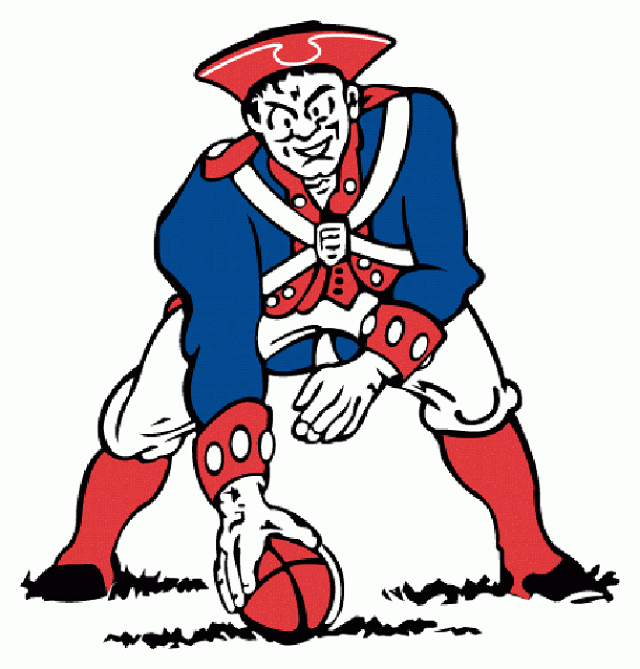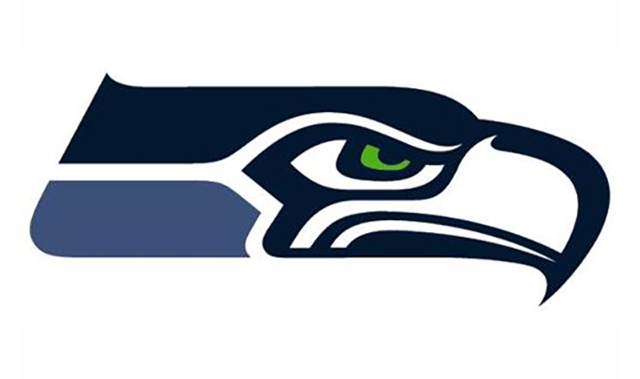On February 1, Super Bowl XLIX ("49" for those of us who don't quite get Roman numerals) will take place, and over 63,000 fans will converge on the University of Phoenix Stadium in Arizona. Many of those fans will be sporting the logos of the New England Patriots or Seattle Seahawks. But how did those logos get to us? How were they designed?
The New England Patriots Logo
The logo most patriots fans associate with the team is the eponymous 'Pat Patriot,' which was used for over 30 years before being retired in 1992. A fan favorite to this day, Pat was suited for a quainter, more mascot-friendly time: a New England Minuteman in garb from circa 1776, complete with tri-corner, hunched over and about to hike the ball to an invisible QB.

Pat Patriot was designed in 1960 by Phil Bissell, a cartoonist for the Boston Globe who drew Pat after a vote in the paper resulted in Boston's new football team being christened the 'Boston Patriots.' The nascent Patriots brand didn't have many official materials at that point, and then team owner Billy Sullivan paid Bissell $100 to "let us use it for a year on our stationary," according to Boston's News 10.
And for a year, that's exactly where Pat stayed. Meanwhile, for their first season, the newly christened Patriots took to the field with a tri-corner hat for a logo. But in 1961, the cartoonish Pat mascot made the jump to the side of player helmets. From 1961 to 1965, Pat adorned jerseys, pendants, and other Patriots merchandise pretty much exactly as Bissell had drawn him.
But despite the inauspicious beginnings, no part of Pat's design was unconsidered, as Bissell recounted to News 10:
When designing Pat, Bissell recalled what the cartoon would need to make the perfect design.
"He's got to be tough. He's got to get in the trenches and dig. That's why, if you notice, his hands are all grimy—because he's dug. He doesn't have nice little white gloves on like Elvis," said Bissell.

But Bissell had drawn Pat very much in the style of a newspaper cartoon. With his clownish white face, pinpoint eyes, and cockeyed grin, Pat wouldn't have looked out of place in a L'il Abner comic. So in 1965, the Patriots logo was redrawn in-house to make him look a little less like he'd just leaped off the comics page: his outfit was redrawn to feature more detail, his face became more realistic, and his flesh was colored in.
This more humanist iteration of Pat would become the Patriots' logo for the next 28 years. But it wasn't uncontested. In 1979, to celebrate the upcoming 20th Anniversary of the team, the recently rechristened "New England Patriots"designed a new prototype helmet logo, then let fans vote on whether to keep Pat or go with the new look. According to Snot Bubble Football, fans overwhelmingly voted to keep Pat Patriot.

But behind the scenes, the Patriots were starting to sour on Pat. True, he was a sentimental favorite with players, management, and the fans. But from a design-perspective, he was complicated to reproduce in different mediums: Pat might look great on the side of a football helmet, but the logo's detail might not hold up as well in a television ad. Every time it was used in another context, it needed to be tweaked to get right.
According to an an ESPN piece from 2011, these considerations were what caused the Patriots to design a new logo in 1979. That design was created by Micéal Chamberlain, the Patriots' marketing manager, who also happened to be then-owner Billy Sullivan's son-in-law. Chamberlain said that the original plan wasn't to allow fans to vote on the new logo at all. It was only a last-minute bout of cold feet on Sullivan's part that resulted in the vote that reprieved Pat from execution. The new logo—a profile shot of a Minuteman patriot with a flag streaming from the back of his head—was shelved indefinitely.

In 1993, the Patriots finally ditched Pat. And curiously, they did so in favor of a design that was very similar to Chamberlain's 1979 design. So similar, in fact, that it's hard to believe that the 1993 logo, often called Flying Elvis by fans, wasn't inspired by it. But its creators, California-based designer Steven Evenson and his then-intern Ken Loh, downplayed any strong connection between the two in talking to ESPN.
"NFL Properties did show us the 1979 logo," he said. "But it was described as something the fans hated, so I tried very hard not to emulate it. You could say my concept was loosely based on that logo, if by 'concept' you mean a profile of a soldier with a flag coming off the back of his head. But I knew I wanted it to be far more streamlined. The concept of a profile/flag is fairly generic and common, and can be interpreted many different ways."
Regardless of whether or not the 1979 and 1993 logo share the same inspiration, the 1993 logo has lasted a long time: 22 years and counting (with a few alterations, of course). And what is unique about all of the Patriots logos is that they were effectively designed by amateurs. Phil Bissell was just a cartoonist when he designed the Pats logo in 1960 for $100. Micéal Chamberlain was just the owner's son-in-law looking to make his job easier when he did the same thing in 1979. And Kenny Loh was a visual communications student when he first sketched the design that would become Flying Elvis back in 1993.
The Patriots might be one of the biggest franchises in the league, but each and every one of their logos has had a humble beginning.
The Seattle Seahawks Logo
Just like the Patriots logo, the logo for the Seattle Seahawks also had humble beginnings. But they didn't start with a cartoonist. It started with the Native Americans.

Long before the northwest corner of Washington state was settled, it was inhabited by Native American tribes, including the Tlingit, Haida, Tsimshian and Kwakwaka'wakw tribes, who roamed as far up as Alaska, and whose impact upon the design aesthetic of the Pacific Northwest (thanks to their masks and totem poles) has continued to this day.
Like the Patriots, the Seahawks name was the result of a popular vote. In 1975, Seattleites submitted 1,741 different suggestions for the name of their new NFL team, including the "Cool Dudes," the "Bumber Shoots," and the "Space Needlers." But when the Seahawks found their name, the NFL looked to the design heritage of the Pacific Northwest for inspiration for a logo, as reported by the Northwest Indian News in September 1975:
(Seahawks general manager) Thompson said the NFL firm did refer to some books on Northwest Indian culture. "Our intent was to follow the Northwest Indian culture, but there was no condition placed on them (NFL) in designing."

According to the Burke Museum, the book the NFL's in-house design team ended up referencing was Robert Bruce Inverarity's 1950 book, Art of the Northwest Coast Indians, which featured a striking image of a Kwakwaka'wakw transformation mask. The mask depicts a heavy-lidded eagle with the exact same profile as the current Seahawks logo. When the mask was opened during a ceremonial dance, you could see a human face inside.

Looking at the profile of the Kwakwaka'wakw mask, it's hard to believe that the Seahawks logo is anything besides a trace job. Most of the details are the same, from the hawk's heavily-lidded eye, to silhouette of the head and the lines around the beak. But even though the mask this design was based on was hundreds of years old, it turned out to be incredibly well-suited for the side of a football helmet, even if it did cause a little mini-controversy for not adhering exactly to the style of the Kwakwaka'wakw[/url].
Before a photo of the mask itself was published in Inverarity's book, it had quite the journey, according to City Lab. After being purchased in 1910 by the Fred Harvey Company, which was known for its hotels, restaurants, and marketplaces across the Southwest U.S. it was picked up by surrealist Max Ernst before finally settling at the University of Maine's Hudson Museum.
What's interesting about the Seahawks logo when compared to the 1979 Patriots logo that almost replaced Pat Patriot, is how similar they are. Both are literal interpretations of the team name in profile, streaming stripes behind them. Both are oriented on a horizontal plane, and use a minimum of colors to make it easy to reproduce them in multiple mediums—what we'd today call a "flat design," almost 40 years before Google and Apple popularized the term. And both are incredibly dynamic, almost arrows on the side of a player's helmet: a streak of motion, heading towards the end zone. And it's barely changed since.

In 2002, the Seahawks introduced a leaner, fiercer, and even flatter version of their logo, yet the design heritage of the logo remains clear: it is an evolution of the old logo, not a redesign. Even the frowning mouth is the same. The Seahawks, it seems, got their logo right pretty much the first time around.